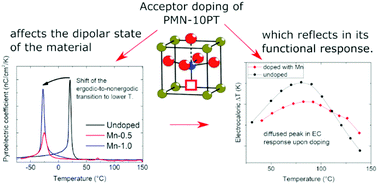Implications of acceptor doping in the polarization and electrocaloric response of 0.9Pb(Mg1/3Nb2/3)O3–0.1PbTiO3 relaxor ferroelectric ceramics†
Abstract
In ferroelectrics, the effects of acceptor doping on electrical and electromechanical properties, often referred to as the “hardening” effects, are commonly related to domain-wall pinning mechanisms mediated by acceptor-oxygen-vacancy defect complexes. In contrast, the hardening effects in relaxor ferroelectric materials are complicated by the nano-polar nature of these materials, the associated dynamics of the polar nano-regions and their contribution to polarization, and the characteristic freezing transition between the ergodic and the non-ergodic phases. To shed light on this issue, in this study, we investigate the role of the acceptor (Mn) doping on the temperature-dependent broadband dielectric permittivity, high-field polarization–electric-field (P–E) hysteresis and electrocaloric (EC) response of 0.9Pb(Mg1/3Nb2/3)O3–0.1PbTiO3 (PMN-10PT) relaxor ferroelectric ceramics. The results suggest strong pinning effects, mediated by the acceptor–oxygen-vacancy defect complexes, which manifest similarly both in the ergodic and in the non-ergodic phases of PMN-10PT as revealed by the doping-induced suppression of the frequency dispersion of the permittivity maximum and pinched high-field hysteresis loops. In addition to these pinning effects, the Mn doping reduces the freezing temperature (Tf) by ∼50 °C with respect to the undoped PMN-10PT. This is reflected in the EC response, which becomes less temperature dependent, making defect engineering a valuable approach for designing EC materials with an extended operational temperature range.



 Please wait while we load your content...
Please wait while we load your content...